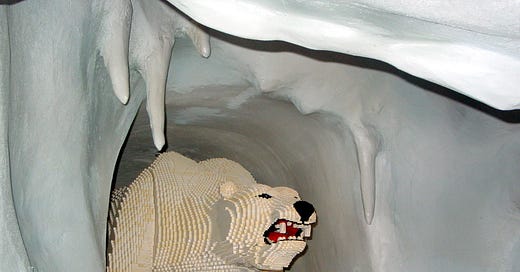When Your Kid is Scared of a LEGO Polar Bear
or a sneezing king or the banging of a piñata or something else
Here are some notable things my young children have been scared of over the last few years: the king’s kerchoo in the Dr. Seuss alphabet book, a photograph of an ostrich, the smashing of a beloved piñata at a birthday party, the removal of a tick from behind a sibling’s ear, and a large, growling robotic LEGO polar bear at LEGOLAND.
Let’s break apart that LEGO bear situation as an example of a kid being afraid of something and a parent (me) trying my best to help her through it. My daughter “Ed” (age 1.5 at the time) and I were walking around LEGOLAND together waiting for our crew to finish lunch when we stumbled upon an arctic haunted house type attraction. After checking out some wolves, we turned the corner and encountered a white hallway with a growling polar bear that completely terrified Ed.
She ran back to me, crying and I scooped her up and held her close. This is the phase of fear where I simply aim to accept and acknowledge how the child feels: “oy. you feel scared of that polar bear. I’ve got you. I’ll hold you. You’re safe.”
No matter how cute or '“silly” the fear is, when a child is scared and they are in that fight or flight state, we must appeal to their soft little animal body: their nervous system, not their logical brain. I’m a safe place for her so I try to co-regulate: “we can move past here and go outside. I’ve got you. You’re safe.” Knowing there was no real threat, I said it calmly, while casually moving her away from the bear – I wanted her to feel my ease because it wasn’t an actual emergency.
Next we process. There’s a strategy in the Whole Brain Child (a book I highly recommend, btw, it’s helped me a lot) called “Name it to Tame it” – I think they’ve since reworded it to read, “Name it to Reframe it” in an effort to highlight hearing the child/helping the child reach a new perspective without unintentionally diminishing the child’s experience. Essentially, the strategy invites adults to talk to their children about hard things in order to help them make sense of the world. I try to use this strategy all. the. time.
We go over what happened, step-by-step: “First we saw the wolf, then we were walking along and that bear came out of her cave and started growling and you felt scared. Then I picked you up and we walked out. You were crying and now you’re not crying.” I do this so that my child feels seen and understood. I do this so that my child can return to the event and process it as many times as she needs to (we talked about this bear for many, many months after our trip – she’ll still bring it up sometimes, a year later).
After I named what happened and thought Ed was in a state where her brain could actually receive information (she wasn’t still freaking out) I tried to help her make sense of what happened by being as honest and matter of fact as possible. This is the “reframing” piece: “that bear was designed to be scary – there was a loud growling noise and the bear popped out from a cave and opened its mouth. The bear is made from plastic LEGOs. They made it out of white pieces because they wanted it to look like a polar bear. It is not a real bear. It’s something called a robot.” This is the way that I was speaking to my 1.5 year old – I’m a huge believer in speaking to even the youngest infant with honest and respectful candor. This isn’t so much in an effort to dissuade them from being scared, but rather to help them figure out, over time, which things pose genuine risk and which things are predictable, understandable, and safe (even if they are unpleasant).
Throughout all of this, but in this last part especially, I try to follow my child’s lead about what they need next. In this situation, Ed wanted to return to the dang polar bear again and again and again. I think we did five laps through that place before moving on. Though I didn’t really want to deal with the potential fallout of her being frightened again, we went back when she expressed interest: “sure, we can go back to see the bear again. I’ll be with you and trust that you’ll let me know if you need me.”
Here we are on maybe lap four — the first time I felt comfortable filming the situation because, as you can see, she’s more confident, still quite scared, but able to observe the bear more closely this time:
Here are some things I tried to NOT do.
I tried not to shame my child by diminishing her fears, “that’s just a silly bear – there’s nothing to be afraid of.” Knowing that toddlers eventually turn into teenagers, I’m trying to build a relationship in which my children feel comfortable coming to me with their fears.
I didn’t laugh or take pictures of her when she felt really scared, because, well, that’s not nice. I see a surprising number of adults do this – have you ever seen parents take pictures of screaming children on Santa’s lap, laughing at their experience?
I also tried not to protect her from revisiting the scene – I think there’s a way to take children seriously and help them build their capacity for resilience by continuing to expose them to situations that challenge them.
Dr. Sarah Bren (a clinical psychologist whose work I admire) has a podcast episode on anxiety in which she says parents should help their children “bend not break” when it comes to fears – children don’t need us to protect them from all of life’s adversities because overcoming adversity gives children confidence and builds their resilience over time, but we need to know what’s within our children’s limits.
I very, very much believe in sentiment over scripts and sincerity over steps. But in case your brain likes a bullet point, here is a rough outline of the sequence I described above:
Accept and acknowledge the child’s fears (no matter how cute or “silly” they seem to you)
Respond to your child to help them regulate and feel safe (by hugging them or holding them or moving them from the thing)
Process by telling your child the story (leaving plenty of space for them to add in details, as their language progresses)
Explicitly explain the realities of the situation, being honest and open – I really believe children appreciate truths
Follow their lead about what they need next, making sure that you’re not unintentionally assuming they will forever be scared of the thing
Essentially, we want to take our children seriously but also help them make sense of the world, gaining ever more accurate ideas about the relative risk of any situation and their agency and ability to problem solve around it.
Because tomorrow is Halloween, I wanted to outline my general approach to addressing children’s fears. I have to acknowledge the immensity of privilege I have writing about these sweet childlike fears, knowing full-well that children are currently facing the most traumatizing of horrors. Sometimes I feel debilitated by the immensity of the atrocities and sometimes I feel even more motivated to try to help parents build the deeply caring and empathetic world we all believe in.
Let’s be kind to kids. Let’s protect them and respect them and take them seriously. Let’s meet them where they are and give them space to grow.
Warmly,
Courtney






As always, such thoughtful, child-centered advice! Thank you!
Beautiful piece as always, Court ❤️🩷